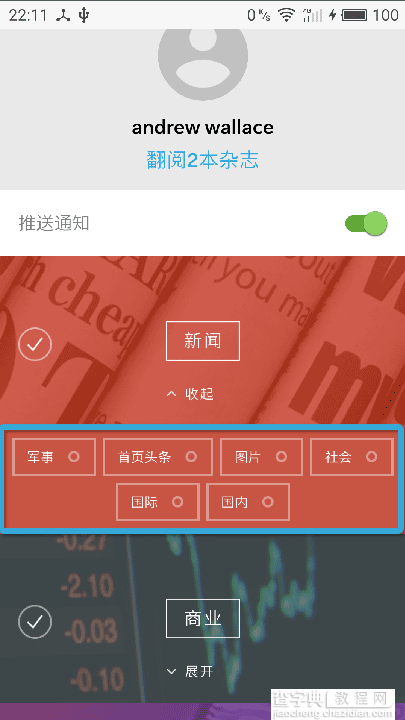在Android开发中,View是我们必须要接触的用来展示的技术.通常情况下随着View视图的越来越复杂,整体布局的性能也会随之下降.这里介绍一个在某些场景下提升布局性能的View,它就是ViewStub.
ViewStub是什么
ViewStub是View的子类 它不可见,大小为0 用来延迟加载布局资源
注,关于Stub的解释
A stub is a small program routine that substitutes for a longer program, possibly to be loaded later or that is located remotely
在Java中,桩是指用来代替关联代码或者未实现代码的代码.
ViewStub使用场景

如上图所示,
一个ListView包含了诸如 新闻,商业,科技 等Item 每个Item又包含了各自对应的子话题, 但是子话题的View(蓝色区域)只有在点击展开按钮才真正需要加载. 如果默认加载子话题的View,则会造成内存的占用和CPU的消耗
所以,这时候就ViewStub就派上用处了.使用ViewStub可以延迟加载布局资源.
ViewStub 怎么用
在布局文件中使用ViewStub标签
<"1.0" encoding="utf-8"?> <RelativeLayout xmlns:android="http://schemas.android.com/apk/res/android" xmlns:tools="http://schemas.android.com/tools" android:layout_width="match_parent" android:layout_height="match_parent" android:paddingLeft="@dimen/activity_horizontal_margin" android:paddingRight="@dimen/activity_horizontal_margin" android:paddingTop="@dimen/activity_vertical_margin" android:paddingBottom="@dimen/activity_vertical_margin" tools:context="com.droidyue.viewstubsample.MainActivity"> <Button android:id="@+id/clickMe" android:text="Hello World!" android:layout_width="wrap_content" android:layout_height="wrap_content"/> <ViewStub android:id="@+id/myViewStub" android:inflatedId="@+id/myInflatedViewId" android:layout="@layout/include_merge" android:layout_width="wrap_content" android:layout_height="wrap_content" android:layout_below="@id/clickMe" /> </RelativeLayout>
2.在代码中inflate布局
ViewStub myViewStub = (ViewStub)findViewById(R.id.myViewStub); if (myViewStub != null) { myViewStub.inflate(); //或者是下面的形式加载 //myViewStub.setVisibility(View.VISIBLE); }
关于ViewStub的事
除了 inflate 方法外,我们还可以调用 setVisibility() 方法加载布局文件
一旦加载布局完成后,ViewStub会从当前布局层级中删除
android:id 指定ViewStub ID,用于查找ViewStub进行延迟加载
android:layout 延迟加载布局的资源id
android:inflatedId 加载的布局被重写的id,这里为RelativeLayout的id
ViewStub的不足
官方的文档中有这样一段描述
Note: One drawback of ViewStub is that it doesn't currently support the tag in the layouts to be inflated.
意思是ViewStub不支持 <merge> 标签.
关于不支持 <merge> 标签的程度,我们进行一个简单的验证
验证一:直接 标签
如下,我们有布局文件名为 merge_layout.xml
<merge xmlns:android="http://schemas.android.com/apk/res/android"> <Button android:layout_width="fill_parent" android:layout_height="wrap_content" android:text="Yes"/> <Button android:layout_width="fill_parent" android:layout_height="wrap_content" android:text="No"/> </merge>
替换对应的ViewStub的android:layout属性值之后,运行后(点击Button按钮)得到产生了如下的崩溃
E AndroidRuntime: android.view.InflateException: Binary XML file line #1: <merge /> can be used only with a valid ViewGroup root and attachToRoot=true
E AndroidRuntime: at android.view.LayoutInflater.inflate(LayoutInflater.java:551)
E AndroidRuntime: at android.view.LayoutInflater.inflate(LayoutInflater.java:429)
E AndroidRuntime: at android.view.ViewStub.inflate(ViewStub.java:259)
E AndroidRuntime: at com.droidyue.viewstubsample.MainActivity$1.onClick(MainActivity.java:20)
E AndroidRuntime: at android.view.View.performClick(View.java:5697)
E AndroidRuntime: at android.widget.TextView.performClick(TextView.java:10815)
E AndroidRuntime: at android.view.View$PerformClick.run(View.java:22526)
E AndroidRuntime: at android.os.Handler.handleCallback(Handler.java:739)
E AndroidRuntime: at android.os.Handler.dispatchMessage(Handler.java:95)
E AndroidRuntime: at android.os.Looper.loop(Looper.java:158)
E AndroidRuntime: at android.app.ActivityThread.main(ActivityThread.java:7237)
E AndroidRuntime: at java.lang.reflect.Method.invoke(Native Method)
E AndroidRuntime: at com.android.internal.os.ZygoteInit$MethodAndArgsCaller.run(ZygoteInit.java:1230)
E AndroidRuntime: at com.android.internal.os.ZygoteInit.main(ZygoteInit.java:1120)
E AndroidRuntime: Caused by: android.view.InflateException: <merge /> can be used only with a valid ViewGroup root and attachToRoot=true
E AndroidRuntime: at android.view.LayoutInflater.inflate(LayoutInflater.java:491)
E AndroidRuntime: ... 13 more
可见,直接的 <merge> 标签,ViewStub是不支持的.
验证二 间接的ViewStub
下面布局间接使用了merge标签.文件名为 include_merge.xml
<"1.0" encoding="utf-8"?> <LinearLayout xmlns:android="http://schemas.android.com/apk/res/android" android:orientation="vertical" android:layout_width="match_parent" android:layout_height="match_parent"> <include layout="@layout/merge_layout"/> </LinearLayout>
然后修改ViewStub的 android:layout 值,运行,一切正常.
除此之外,本例也验证了ViewStub也是对 <include> 标签支持良好的.
关于ViewStub的一点代码剖析
inflate vs setVisibility
inflate和setVisibility的共同点是都可以实现加载布局
/** * When visibility is set to {@link #VISIBLE} or {@link #INVISIBLE}, * {@link #inflate()} is invoked and this StubbedView is replaced in its parent * by the inflated layout resource. * * @param visibility One of {@link #VISIBLE}, {@link #INVISIBLE}, or {@link #GONE}. * * @see #inflate() */ @Override public void setVisibility(int visibility) { if (mInflatedViewRef != null) { View view = mInflatedViewRef.get(); if (view != null) { view.setVisibility(visibility); } else { throw new IllegalStateException("setVisibility called on un-referenced view"); } } else { super.setVisibility(visibility); if (visibility == VISIBLE || visibility == INVISIBLE) { inflate(); } } }
setVisibility只是在ViewStub第一次延迟初始化时,并且visibility是非 GONE 时,调用了 inflate 方法.
inflate源码
通过阅读下面的inflate方法实现,我们将更加理解
android:inflatedId的用途 ViewStub在初始化后从视图层级中移除 ViewStub的layoutParameters应用 mInflatedViewRef通过弱引用形式,建立ViewStub与加载的View的联系.
/** * Inflates the layout resource identified by {@link #getLayoutResource()} * and replaces this StubbedView in its parent by the inflated layout resource. * * @return The inflated layout resource. * */ public View inflate() { final ViewParent viewParent = getParent(); if (viewParent != null && viewParent instanceof ViewGroup) { if (mLayoutResource != 0) { final ViewGroup parent = (ViewGroup) viewParent; final LayoutInflater factory = LayoutInflater.from(mContext); final View view = factory.inflate(mLayoutResource, parent, false); if (mInflatedId != NO_ID) { view.setId(mInflatedId); } final int index = parent.indexOfChild(this); parent.removeViewInLayout(this); final ViewGroup.LayoutParams layoutParams = getLayoutParams(); if (layoutParams != null) { parent.addView(view, index, layoutParams); } else { parent.addView(view, index); } mInflatedViewRef = new WeakReference<View>(view); if (mInflateListener != null) { mInflateListener.onInflate(this, view); } return view; } else { throw new IllegalArgumentException("ViewStub must have a valid layoutResource"); } } else { throw new IllegalStateException("ViewStub must have a non-null ViewGroup viewParent"); } }
关于ViewStub的研究就是这些,希望对大家关于优化视图有所帮助和启发.
【Android中使用ViewStub实现布局优化】相关文章:
★ Android为ListView的Item设置不同的布局
★ 基于Android中的 AutoCompleteTextView实现自动填充
